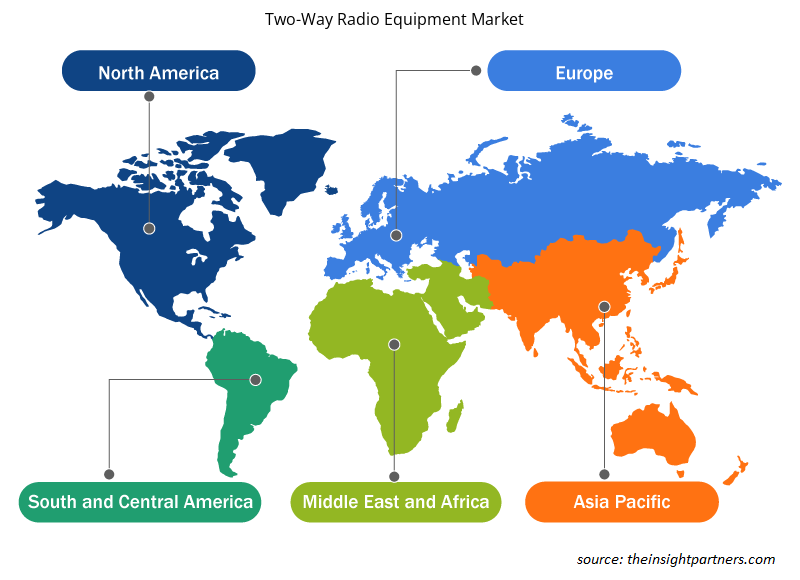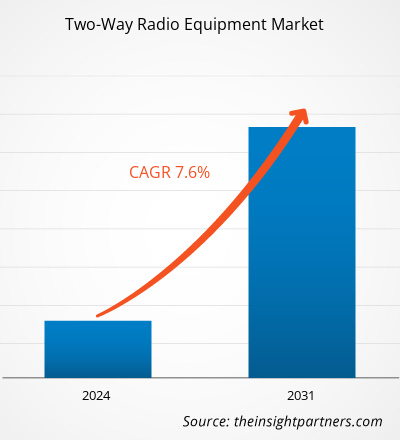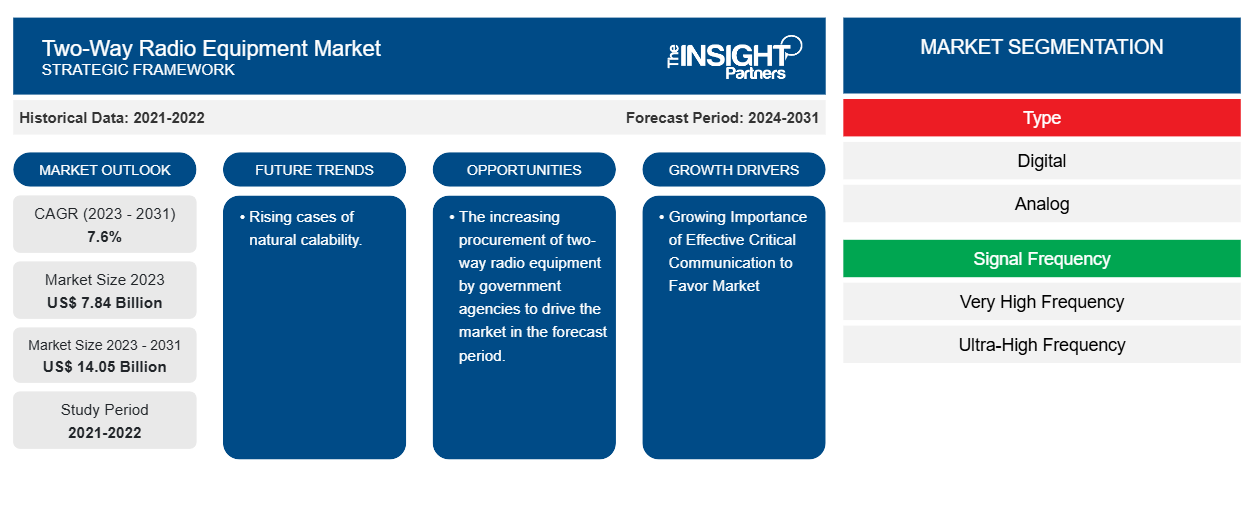Si prevede che la dimensione del mercato delle apparecchiature radio bidirezionali raggiungerà i 14,05 miliardi di dollari entro il 2031, rispetto ai 7,84 miliardi di dollari del 2023. Si prevede che il mercato registrerà un CAGR del 7,6% nel periodo 2023-2031. La crescente adozione della radio bidirezionale digitale rispetto alle apparecchiature analogiche e la crescente domanda di apparecchiature radio bidirezionali nella produzione di sensori saranno probabilmente i principali driver e tendenze del mercato.
Analisi del mercato delle apparecchiature radio bidirezionali
Il mercato delle apparecchiature radio bidirezionali sta vivendo una significativa crescita a livello globale. Questa crescita è attribuita a fattori quali la crescente adozione della radio bidirezionale digitale rispetto alle apparecchiature analogiche e la crescente domanda di apparecchiature radio bidirezionali nella produzione di sensori. Inoltre, si prevede che l'aumento degli acquisti di apparecchiature radio bidirezionali da parte di agenzie governative guiderà la crescita del mercato nei prossimi anni.
Panoramica del mercato delle apparecchiature radio bidirezionali
Una radio bidirezionale è considerata un ricetrasmettitore radio. Questa radio può sia comunicare che ricevere onde radio, che vengono utilizzate per la comunicazione vocale bidirezionale da persona a persona con altri utenti con radio simili, a differenza di un ricevitore di trasmissione, che riceve solo trasmissioni. Le radio bidirezionali di solito utilizzano un canale di comunicazione half-duplex, che autorizza la comunicazione bidirezionale, anche se con la limitazione che solo un utente può trasmettere alla volta.
Personalizza questo report in base alle tue esigenze
Riceverai la personalizzazione gratuita di qualsiasi report, comprese parti di questo report, o analisi a livello nazionale, pacchetto dati Excel, oltre a usufruire di grandi offerte e sconti per start-up e università
-
Scopri le principali tendenze di mercato in questo rapporto.Questo campione GRATUITO includerà analisi di dati che spaziano dalle tendenze di mercato alle stime e alle previsioni.
Driver e opportunità del mercato delle apparecchiature radio bidirezionali
Crescente importanza della comunicazione critica efficace per favorire il mercato.
La crescente importanza di una comunicazione critica efficace sta davvero guidando il mercato. La tecnologia radio bidirezionale si è evoluta dalla tradizionale voce analogica a sistemi complessi con capacità di trunking e digitali che consentono funzionalità quali chiamate di gruppo, rapida configurazione delle chiamate vocali, audio di alta qualità e accesso prioritario garantito all'utente finale. Con l'aumento di criminalità, terrorismo e disastri naturali, le industrie sono tenute ad adottare nuove tecnologie per consentire reazioni rapide ed efficaci in tempo reale. Una comunicazione efficace è fondamentale per i soccorritori della sicurezza pubblica che devono rimanere connessi al centro di controllo e allo stesso tempo acquisire informazioni situazionali in tempo reale quando reagiscono alle situazioni.
Crescenti casi di calamità naturale.
I crescenti casi di calamità naturali, tra cui uragani, terremoti, incendi e inondazioni, hanno aumentato significativamente la domanda di sistemi vocali affidabili, agendo così da motore per il mercato delle apparecchiature radio bidirezionali. A settembre 2023, secondo la National Oceanic and Atmospheric Administration, gli Stati Uniti hanno subito ben 23 disastri meteorologici e climatici distinti, ciascuno dei quali ha causato almeno 1 miliardo di dollari di danni. Durante tali disastri naturali, le infrastrutture di comunicazione tradizionali come le reti cellulari e la connettività Internet possono spesso essere interrotte a causa di infrastrutture danneggiate o sovraccarico. In tali situazioni, i soccorritori, le agenzie governative e le organizzazioni di soccorso fanno molto affidamento sulla radio bidirezionale per le comunicazioni critiche, poiché offrono capacità di comunicazione robuste e resilienti.
Analisi della segmentazione del rapporto di mercato delle apparecchiature radio bidirezionali
I segmenti chiave che hanno contribuito alla derivazione dell'analisi di mercato delle apparecchiature radio bidirezionali sono la tipologia, la frequenza del segnale e il settore di utilizzo finale.
- In base al tipo, il mercato delle apparecchiature radio bidirezionali è diviso in digitale e analogico. Si prevede che il segmento digitale detenga una quota di mercato significativa nel periodo di previsione.
- In base alla frequenza del segnale, il mercato delle apparecchiature radio bidirezionali è suddiviso in frequenza molto alta (VHF) e frequenza ultra alta (UHF). Si prevede che il segmento a frequenza molto alta (VHF) deterrà una quota di mercato significativa nel periodo di previsione.
- Per settore di utilizzo finale , il mercato è segmentato in governo e sicurezza pubblica, produzione, servizi di pubblica utilità, trasporti e logistica, istruzione, ospitalità e altri. Si prevede che il segmento governo e sicurezza pubblica detenga una quota di mercato significativa nel periodo di previsione.
Analisi della quota di mercato delle apparecchiature radio bidirezionali per area geografica
L'ambito geografico del rapporto sul mercato delle apparecchiature radio bidirezionali è suddiviso principalmente in cinque regioni: Nord America, Asia Pacifico, Europa, Medio Oriente e Africa, e Sud e Centro America.
Il Nord America ha dominato il mercato delle apparecchiature radio bidirezionali. Le tendenze di adozione di tecnologie elevate in vari settori della regione nordamericana hanno alimentato la crescita del mercato delle apparecchiature radio bidirezionali. Si prevede che fattori come l'adozione crescente di strumenti digitali e l'elevata spesa tecnologica da parte delle agenzie governative guideranno la crescita del mercato delle apparecchiature radio bidirezionali nordamericane. La crescente adozione della radio bidirezionale digitale rispetto alle apparecchiature analogiche e la crescente domanda di apparecchiature radio bidirezionali nella produzione di sensori. Inoltre, una forte enfasi sulla ricerca e sviluppo nelle economie sviluppate degli Stati Uniti e del Canada sta costringendo gli operatori nordamericani a portare sul mercato soluzioni tecnologicamente avanzate. Inoltre, gli Stati Uniti hanno un gran numero di operatori del mercato delle apparecchiature radio bidirezionali che si sono sempre più concentrati sullo sviluppo di soluzioni innovative. Tutti questi fattori contribuiscono alla crescita del mercato delle apparecchiature radio bidirezionali nella regione.
Approfondimenti regionali sul mercato delle apparecchiature radio bidirezionali
Le tendenze regionali e i fattori che influenzano il mercato delle apparecchiature radio bidirezionali durante il periodo di previsione sono stati ampiamente spiegati dagli analisti di Insight Partners. Questa sezione discute anche i segmenti e la geografia del mercato delle apparecchiature radio bidirezionali in Nord America, Europa, Asia Pacifico, Medio Oriente e Africa e America meridionale e centrale.

- Ottieni i dati specifici regionali per il mercato delle apparecchiature radio bidirezionali
Ambito del rapporto di mercato sulle apparecchiature radio bidirezionali
| Attributo del report | Dettagli |
|---|---|
| Dimensioni del mercato nel 2023 | 7,84 miliardi di dollari USA |
| Dimensioni del mercato entro il 2031 | 14,05 miliardi di dollari USA |
| CAGR globale (2023-2031) | 7,6% |
| Dati storici | 2021-2022 |
| Periodo di previsione | 2024-2031 |
| Segmenti coperti |
Per tipo
|
| Regioni e Paesi coperti |
America del Nord
|
| Leader di mercato e profili aziendali chiave |
|
Densità degli operatori del mercato delle apparecchiature radio bidirezionali: comprendere il suo impatto sulle dinamiche aziendali
Il mercato delle apparecchiature radio bidirezionali sta crescendo rapidamente, spinto dalla crescente domanda degli utenti finali dovuta a fattori quali l'evoluzione delle preferenze dei consumatori, i progressi tecnologici e una maggiore consapevolezza dei vantaggi del prodotto. Con l'aumento della domanda, le aziende stanno ampliando le loro offerte, innovando per soddisfare le esigenze dei consumatori e capitalizzando sulle tendenze emergenti, il che alimenta ulteriormente la crescita del mercato.
La densità degli operatori di mercato si riferisce alla distribuzione di aziende o società che operano in un particolare mercato o settore. Indica quanti concorrenti (operatori di mercato) sono presenti in un dato spazio di mercato in relazione alle sue dimensioni o al valore di mercato totale.
Le principali aziende che operano nel mercato delle apparecchiature radio bidirezionali sono:
- Società a responsabilità limitata BK Technologies Inc.
- Gruppo Bearcom Inc.
- Società di comunicazione Hytera Ltd.
- Icom America Inc.
- Società radiofonica Midland
- Motorola Solutions Inc.
Disclaimer : le aziende elencate sopra non sono classificate secondo un ordine particolare.

- Ottieni una panoramica dei principali attori del mercato delle apparecchiature radio bidirezionali
Notizie e sviluppi recenti sul mercato delle apparecchiature radio bidirezionali
Il mercato delle apparecchiature radio bidirezionali viene valutato raccogliendo dati qualitativi e quantitativi dopo la ricerca primaria e secondaria, che include importanti pubblicazioni aziendali, dati associativi e database. Di seguito sono elencati alcuni degli sviluppi nel mercato delle apparecchiature radio bidirezionali:
- Hytera Communications, uno dei principali fornitori mondiali di tecnologie e soluzioni per le comunicazioni professionali, ha recentemente rilasciato la sua ultima serie di radio intrinsecamente sicure (IS), tra cui la radio portatile bidirezionale HP79XEx DMR e la radio portatile PT890Ex TETRA. (Fonte: sito Web aziendale Hytera Communications, novembre 2023)
- Motorola Solutions ha annunciato il lancio di MOTOTRBO R7 in Europa, Medio Oriente e Africa. La nuova radio digitale bidirezionale offriva funzionalità audio avanzate e un design sottile e robusto per collegare i team in ambienti rumorosi, difficili e dinamici. (Fonte: sito Web aziendale Motorola Solutions, aprile 2022)
Copertura e risultati del rapporto sul mercato delle apparecchiature radio bidirezionali
Il rapporto "Dimensioni e previsioni del mercato delle apparecchiature radio bidirezionali (2021-2031)" fornisce un'analisi dettagliata del mercato che copre le seguenti aree:
- Dimensioni e previsioni del mercato delle apparecchiature radio bidirezionali a livello globale, regionale e nazionale per tutti i principali segmenti di mercato coperti dall'ambito
- Tendenze del mercato delle apparecchiature radio bidirezionali e dinamiche di mercato come driver, restrizioni e opportunità chiave
- Analisi dettagliata delle cinque forze PEST/Porter e SWOT
- Analisi del mercato delle apparecchiature radio bidirezionali che copre le principali tendenze del mercato, il quadro globale e regionale, i principali attori, le normative e i recenti sviluppi del mercato
- Analisi del panorama industriale e della concorrenza che copre la concentrazione del mercato, l'analisi della mappa di calore, i principali attori e gli sviluppi recenti per il mercato delle apparecchiature radio bidirezionali
- Profili aziendali dettagliati
- Analisi storica (2 anni), anno base, previsione (7 anni) con CAGR
- Analisi PEST e SWOT
- Valore/volume delle dimensioni del mercato - Globale, Regionale, Nazionale
- Industria e panorama competitivo
- Set di dati Excel
Report recenti
Rapporti correlati
Testimonianze
Motivo dell'acquisto
- Processo decisionale informato
- Comprensione delle dinamiche di mercato
- Analisi competitiva
- Analisi dei clienti
- Previsioni di mercato
- Mitigazione del rischio
- Pianificazione strategica
- Giustificazione degli investimenti
- Identificazione dei mercati emergenti
- Miglioramento delle strategie di marketing
- Aumento dell'efficienza operativa
- Allineamento alle tendenze normative























 Ottieni un campione gratuito per - Mercato delle apparecchiature radio bidirezionali
Ottieni un campione gratuito per - Mercato delle apparecchiature radio bidirezionali